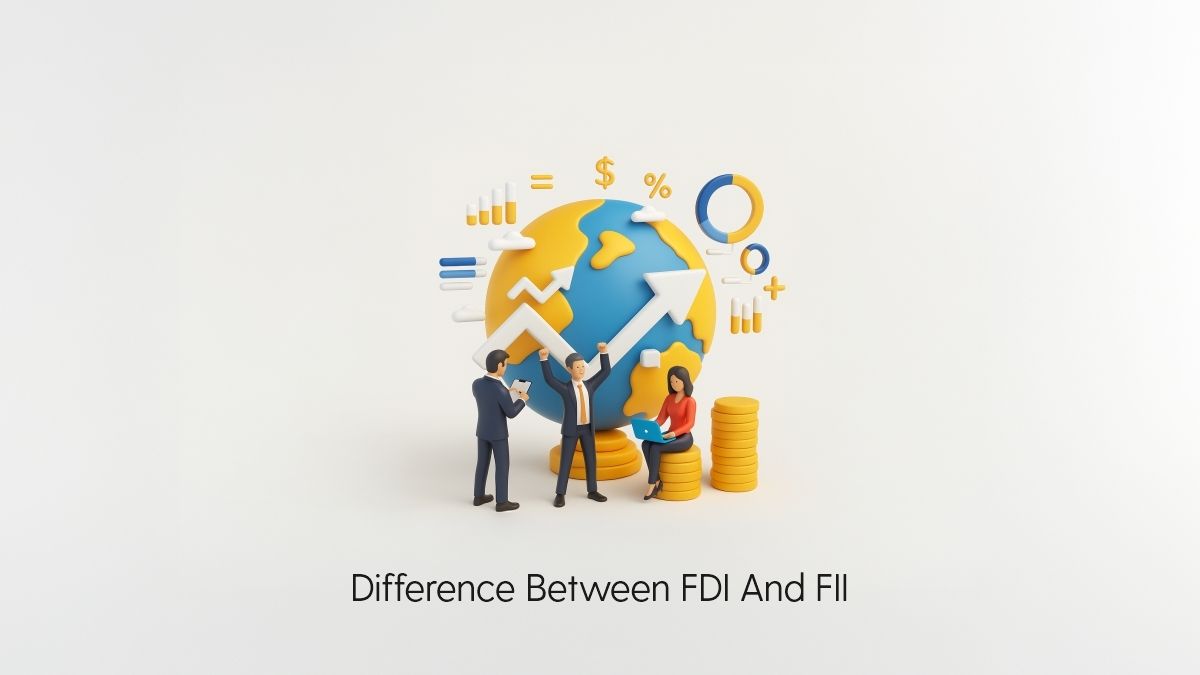FDI vs FII: Key Differences Between FDI and FII

- Published Date: July 01, 2025
- Updated Date: July 17, 2025
- By Team Choice
India, as a growing economy, attracts significant capital from international investors. Two primary forms of this capital are Foreign Direct Investment (FDI) and Foreign Institutional Investment (FII). While both play vital roles in boosting economic development, they function differently. FII DII data is often analysed by market participants to understand investment trends and market sentiment. This comprehensive analysis examines the fundamental differences between Foreign Direct Investment (FDI) and Foreign Institutional Investment (FII), providing retail investors with essential knowledge for informed decision-making.
FDI - Meaning & Features
FDI full-form - Foreign Direct Investment refers to the process by which a company or individual based in one country makes a substantial investment in a business in another country. This typically involves acquiring a significant ownership stake, commonly 10% or more, in a foreign enterprise, or establishing business operations such as subsidiaries, joint ventures, or acquiring physical assets in the target country. In the Indian context, FDI is a major channel for international businesses to access the emerging market opportunities of the country.
Features of Foreign Direct Investment
1. Strategic, Long-Term Commitment: FDI is not intended for short-term gains. It reflects an investor’s intention to establish a long-standing presence in the target market, leveraging sustained economic expansion and long-term opportunities.
2. Ownership and Decision-Making Authority: When foreign investors hold at least a 10% equity stake, they gain significant influence or control over the business’s strategic decisions, often including voting rights in company affairs.
3. Technology and Skill Transfer: One of the major advantages of FDI is the transfer of advanced technology, operational expertise, and managerial know-how from foreign investors. This enhances productivity and contributes to the host country’s overall economic development.
4. Boost to Infrastructure: FDI plays a critical role in enhancing physical and industrial infrastructure. Foreign companies often invest in building facilities, improving logistics, and upgrading supply chains, which further stimulates economic growth.
5. Employment Opportunities: By setting up new operations or expanding existing businesses, foreign investors create jobs for the local population. This not only increases individual income levels but also strengthens the national economy through higher consumption and tax contributions.
6. Exposure to Economic Risks: The long-term nature of FDI exposes investors to long-term risks, including foreign exchange fluctuations, changes in tax regulations, shifts in government policies, and geopolitical instability. These risks can impact profitability and investment sustainability.
FII - Meaning & Features
FII full-form - Foreign Institutional Investment (FII) refers to capital inflow from international financial entities, such as mutual funds, pension funds, hedge funds, and insurance companies, into a country's financial markets. In India, FIIs invest in diverse financial instruments, such as equities, bonds, and debentures, across both primary and secondary markets. These investments are typically aimed at achieving short- to medium-term gains based on market movements and economic trends.
Note: Foreign Institutional Investors (FIIs) fall under the broader umbrella of Foreign Portfolio Investment (FPI). While FPI encompasses all foreign investments in financial assets like stocks and bonds, FIIs refer specifically to institutional entities such as mutual funds, hedge funds, or pension funds that actively trade in a country’s capital markets.
Core Traits of Foreign Institutional Investment
1. Primarily Short-Term in Nature: FII capital is often speculative and geared toward capturing quick returns. Foreign institutional investors usually make decisions based on short- or medium-term market trends.
2. No Operational Control: Unlike FDI, FIIs do not acquire significant ownership stakes that would allow them any managerial or strategic influence over the companies they invest in. Their involvement is strictly financial.
3. Driven by Market Performance: The decision to invest or withdraw is largely influenced by stock market performance, interest rate movements, and macroeconomic indicators. FIIs typically focus on liquid and high-performing assets to maximise return potential.
4. High Liquidity: FII investments are made in highly liquid financial instruments, which can be easily bought or sold. This ease of entry and exit enables investors to manage risk more effectively and respond quickly to market fluctuations.
5. Vulnerable to Market Fluctuations: Due to their short-term orientation and sensitivity to economic indicators, FII flows are highly volatile. Large-scale inflows or sudden exits can significantly impact financial markets.
6. Lower Long-Term Risk Exposure: Since FIIs do not establish a long-term presence or build physical infrastructure, their exposure to long-term country-specific risks, like policy shifts, currency depreciation, or regulatory changes, is minimal compared to FDI.
FDI vs FII: Comparative Analysis
Understanding the difference between FDI vs FII is essential for grasping how international capital impacts various aspects of a nation's economy. The table below outlines their major contrasts across multiple dimensions:
| Comparison Criteria | Foreign Institutional Investment (FII) | Foreign Direct Investment (FDI) |
|---|---|---|
| Definition | Capital inflow from foreign institutions into a country’s stock or bond markets. | Investment made by foreign individuals or firms to establish a business presence. |
| Entry and Exit Flexibility | Quick and easy to invest or withdraw funds. | Fairly strict processes requiring clear timelines and regulatory clearances. |
| Type of Contribution | Provides capital with a short-term focus. | Brings long-term funds, assets, and technical expertise. |
| Economic Impact | Contributes to financial market growth. | Fuels GDP growth and industrial/economic development. |
| Investment Objective | Aimed at profit through market gains and portfolio gains. | Seeks business expansion, technology transfer, and operational setup. |
| Control Over Companies | No influence or management control. | Involves significant control or decision-making rights. |
| Investment Duration | Generally short- to medium-term. | Typically long-term, often spanning decades. |
| Sector Focus | Focuses on liquid assets such as stocks, bonds, and various market instruments. | Focuses on tangible assets like land, factories, and infrastructure. |
| Nature of Investment | Market-driven, fast-moving capital. | Strategic and committed capital allocation. |
| Economic Influence | Affects stock market liquidity and pricing trends. | Influences job creation, industrial growth, and technology development. |
| Target Companies | Broad-based investments across financial markets. | Direct investment in specific companies or industries. |
| Ease of Process | Simpler procedures as regulatory burden is usually smaller. | Complex, requires multiple government approvals. |
| Risk Profile | High exposure to market volatility; quick in and out movement. | Vulnerable to political and regulatory risk, but stable in market volatility. |
| Example | A global hedge fund purchasing shares in an Indian company. | A foreign car manufacturer setting up a production plant in India. |
| Ownership Rights | Does not grant voting or ownership rights. | Provides ownership and voting rights in the business. |
| Value to Investor | Brings capital but limited strategic input. | Provides funds along with innovation, strategies, and global practices. |
| Impact on National Economy | Enhances liquidity in capital markets. | Strengthens core industries and infrastructure. |
Latest FDI and FII Statistics
India experienced a robust surge in foreign investments during the financial year 2024-25, reflecting growing global confidence in its economic resilience and policy framework.
Foreign Direct Investment (FDI)
- Total Inflows: India recorded gross FDI inflows of USD 81.04 billion in FY 2024–25, representing a 14% year-on-year growth compared to USD 71.28 billion in the previous year. This rise underscores India's continued attractiveness as a long-term investment destination.
- Top Sectors Receiving FDI:
- Services - 16.2% of total equity inflows
- Computer Software & Hardware - 15.0%
- Trading - 6.4%
These sectors were the primary magnets for overseas capital, with services and tech maintaining their dominant positions.
- Outward FDI Commitments: India also saw a significant expansion in outbound investments. In April 2025 alone, outward FDI commitments doubled to USD 6.8 billion, with equity participation rising to USD 2.72 billion, reflecting Indian companies’ growing international ambitions.
Foreign Institutional Investment (FII)
- Net Inflows: Net FII/FPI inflows stood at USD 1.21 billion for FY 2024-25, indicating modest but positive sentiment among foreign institutional investors in Indian equity and debt markets.
- Equity Market Activity: Through May 16, 2025, foreign portfolio investors made net equity purchases amounting to ₹23,778 crore, reversing the outflow trend seen in previous quarters. This resurgence highlights increased investor confidence in India's market outlook.
- Market Participation Trend: FIIs (Foreign Institutional Investors) have notably shifted from a selling stance to active accumulation, particularly in key index-heavy sectors, contributing to broader market stability and momentum.
How FDI and FII Contribute to Economic Development?
Both Foreign Direct Investment (FDI) and Foreign Institutional Investment (FII) are crucial drivers of economic development, especially for emerging economies like India. While their approaches and impacts differ, the importance of FDI and FII lies in how they complement each other in strengthening a nation's financial and industrial base.
1. Capital Inflow and Financial Strengthening:
FIIs boost financial market liquidity by investing in equities, bonds, and other financial instruments. This improves the depth of the capital markets and provides companies with easier access to funding.
On the other hand, FDI brings stable, long-term capital into sectors like manufacturing, infrastructure, and technology. This strengthens the country's productive capacity and reduces reliance on domestic capital alone.
2. Boosting Infrastructure and Industrial Growth:
FDI plays a direct role in building infrastructure such as roads, power plants, factories, and logistics hubs. These investments not only generate jobs but also lay the foundation for long-term industrial growth and export capabilities.
FIIs, although not directly involved in infrastructure, create a favourable investment climate by boosting investor confidence and facilitating market growth.
3. Employment Generation:
FDI leads to the creation of direct and indirect jobs in the host country. From skilled managerial positions to blue-collar jobs, FDI helps reduce unemployment and enhances per capita income.
While FII doesn’t directly create jobs, the capital it provides helps companies grow, which can lead to business expansion and subsequent hiring.
4. Transfer of Technology and Innovation:
FDI is a major channel for the transfer of advanced technologies, operational know-how, and global business practices. This increases the productivity and competitiveness of domestic industries, which is particularly important for countries striving for self-reliance and technological advancement.
FIIs, on the other hand, contribute by diversifying the investor base and encouraging companies to maintain higher standards of corporate governance, transparency, and performance.
5. Enhancing Market Efficiency:
FII inflows make capital markets more efficient by improving price discovery, narrowing bid-ask spreads, and reducing the cost of capital for listed companies. It makes the market more appealing to investors from both within and outside the country.
FDI contributes to efficiency by optimising supply chains, improving production methods, and introducing international best practices across sectors.
6. Macroeconomic Stability and Global Integration:
The presence of both FDI and FII helps integrate the domestic economy with global markets. FDI brings long-term economic stability and sectoral development, while FII adds flexibility, liquidity, and global visibility to the country’s financial markets.
Sectoral Analysis: Where FDI and FII Flow?
Understanding which sectors attract the most foreign investment helps retail investors and policymakers identify growth trends and capital allocation priorities. FDI and FII flows differ significantly in terms of sectoral preferences due to their contrasting investment objectives and risk appetites.
Top Sectors Attracting FDI
According to the latest data, India attracted USD 81.04 billion in gross FDI during FY 2024-25, with capital flowing predominantly into long-term, infrastructure-based, and high-tech sectors:
| Sector | FDI Share (%) |
|---|---|
| Services (Financial, Telecom, etc.) | 19% |
| Computer Software & Hardware | 6% |
| Trading | 8% |
| Construction (Infrastructure) | 13% |
| Automobile & Manufacturing | 18% |
Why FDI Targets These Sectors:
- These sectors offer long-term scalability and align with India’s economic growth trajectory.
- FDI investors seek strategic involvement, including technology transfer, logistics development, and business expansion.
- Government incentives like PLI (Production-Linked Incentive) schemes and 100% FDI allowance in specific industries fuel this trend.
Top Sectors Attracting FII (FPI) Investments
Unlike FDI, FII (or FPI) capital, focused on short- to medium-term returns, flows into highly liquid, market-sensitive sectors:
| Preferred Sectors by FIIs | Key Drivers |
|---|---|
| Banking & Financial Services | High liquidity, strong earnings visibility |
| Information Technology (IT) | Global demand, export-driven revenue |
| Consumer Goods & FMCG | Stable demand, consistent cash flows |
| Pharmaceuticals | Defensive play, high growth potential |
| Energy & Infrastructure Funds | Budget allocation and government capex cycles |
Why FIIs Prefer These Sectors:
- These sectors are heavily represented in benchmark indices like Nifty and Sensex.
- FIIs are guided by quarterly earnings, global sentiment, and monetary policy expectations.
- The liquidity and trading volumes in these sectors allow quick entry and exit without impacting prices substantially.
Benefits and Drawbacks of FDI and FII
Key Advantages of FDI and FII:
| Foreign Direct Investment (FDI) | Foreign Institutional Investment (FII) |
|---|---|
| Provides stable and sustained capital for infrastructure, industry, and business growth | Facilitates rapid capital infusions, thereby enhancing liquidity within financial markets |
| Generates employment across sectors, boosting local income and skills | Indirectly supports job growth by fueling market expansion and company growth |
| Introduces modern technology, innovation, and best practices from developed economies | Promotes market efficiency and better governance through professional investor scrutiny |
| Enhances GDP through industrial expansion, exports, and infrastructure development | Encourages local companies to improve their operational efficiency and corporate governance practices to attract investment |
| Creates new opportunities for global trade and fosters integration with international markets | Helps deepen and broaden financial markets, making them more attractive globally |
Disadvantages of FDI and FII:
| Foreign Direct Investment (FDI) | Foreign Institutional Investment (FII) |
|---|---|
| Entry and exit can be complicated due to government approvals and compliance | Rapid withdrawals can trigger market volatility and financial instability |
| Control by foreign entities can raise national interest and policy influence concerns | High dependency on short-term capital can lead to sudden reversals during economic shocks |
| Not all sectors are open to 100% FDI; limits exist in strategic industries | Concentrated investments in specific sectors may lead to asset bubbles |
| Can lead to the displacement of small/local businesses due to the dominance of large foreign firms | FII-driven markets can prioritise short-term gains over long-term value creation |
| Susceptible to political and policy-related risks in the host country | Highly sensitive to global market trends, interest rates, and currency fluctuations |
Risk Assessment Framework for Investors
Foreign investments, whether FDI or FII, bring both opportunities and risks. Retail investors need a structured framework to assess how these global capital movements affect market dynamics, sector performance, and their portfolios.
1. Time Horizon Risk:
| Factor | FDI | FII (FPI) |
|---|---|---|
| Nature | Long-term, strategic | Short- to medium-term, speculative |
| Implication | Stability in sectors with sustained FDI | Volatility due to quick inflow/outflow cycles |
Investor Tip: Match your investment timeline to the right sectors. FDI-heavy sectors like infrastructure suit long-term goals, while FII-driven sectors like IT or BFSI require active monitoring.
2. Liquidity Risk:
- FDI: Typically illiquid; involves direct investments in projects or companies.
- FII: Highly liquid; trades in listed equity and debt instruments.
Investor Tip: Be cautious during periods of high FII outflows, which can lead to sudden price corrections in liquid sectors.
3. Macroeconomic Sensitivity:
FII flows are sensitive to:
- Global interest rates (e.g., US Fed decisions)
- Currency fluctuations (INR depreciation can trigger exits)
- Geopolitical instability
FDI flows are more resilient but can be affected by:
- Policy uncertainty
- Regulatory bottlenecks
Investor Tip: Diversify your portfolio across sectors and asset classes to cushion against FII-induced volatility and external macroeconomic shocks.
4. Regulatory and Policy Risk:
- Government initiatives (e.g., PLI schemes, 100% FDI in telecom) can boost inflows.
- Sudden tax changes or capital control policies may deter FII participation.
Investor Tip: Stay informed about Budget announcements, RBI guidelines, and SEBI regulations that impact foreign investment sentiment.
5. Sectoral Risk:
- Sectors like Banking, IT, and Pharma are FII favourites - susceptible to foreign sentiment shifts.
- Manufacturing, Renewable Energy, and Telecom attract stable FDI.
Investor Tip: Use sector-specific mutual funds or ETFs to manage risk while gaining exposure to foreign capital trends.
Final Thoughts
FDI and FII are both essential for India’s sustained economic progress. While FDI fosters structural growth, FII supports financial market efficiency. However, over-dependence on either can pose risks. A balanced approach, supported by strong regulatory frameworks, can maximise the benefits while minimising the drawbacks of both types of foreign investment.
Frequently Asked Questions (FAQs)
FDI and FII full form?
FDI is the acronym for Foreign Direct Investment, while FII stands for Foreign Institutional Investment.
Why is FDI considered more stable than FII?
FDI involves long-term investments in assets or businesses, making it less susceptible to market volatility. FII, being short-term and market-based, is more prone to sudden inflows and outflows.
Why is Foreign Direct Investment (FDI) important for India's economic growth?
FDI is vital to India’s growth as it brings long-term capital, generates jobs, boosts infrastructure, and introduces advanced technology. The importance of FDI in India also includes enhancing industrial output, improving the trade balance, and strengthening global partnerships.
How does FDI differ from FII in terms of investment purpose and impact?
The primary FDI and FII difference lies in their investment approach. FDI entails long-term ownership and active management of physical assets, such as factories or joint ventures. Conversely, FII involves shorter-term investments in financial markets without exerting control over a company's operations.
What are the primary drawbacks of foreign direct investment in India?
Despite its benefits, FDI has some challenges. The disadvantages of foreign direct investment include the risk of foreign dominance in key industries, potential exploitation of natural resources, displacement of local businesses, and over-dependence on foreign capital.
Recommended for you

FII DII Data - Live Data

Share Market Prediction For Tomorrow

Market Prediction Today (23th December 2025)
